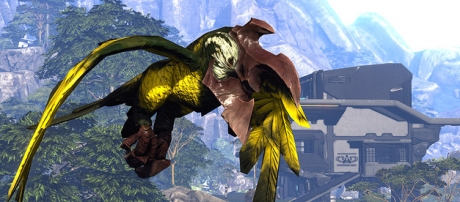
When the Aranha spread to Brazil, they quickly began to decimate the native wildlife population. In a matter of months, many species of parrot and other bird what were already near extinction were wiped out, and species like the Scarlet Macaw and Yellow-faced Amazon parrot dwindled to mere dozens. Sensing a golden opportunity to keep the population of Earth’s newest inhabitants under control, Onmidyne-M contracted research teams to come up with a solution for this growing problem. After a few weeks of debate amongst the team, the decision was made to flip the script and turn the defenseless prey into a dangerous predator.
Over several months, scientists captured the few Yellow-faced Amazon parrots still found in the wild and began to modify their genetic code in minor ways. This included improving their eyesight, expanding their wingspan, and both extending and sharpening their talons. However, the most blatant alteration that was made was to the bird’s beak, which was lengthened and sharpened to fashion a natural weapon against predators.
Their plan worked. Once these new birds, internally dubbed “Harriers” by a particularly awkward member of the research team who found it funny, were released into the wild the Aranha population began to drop. Unfortunately, the intelligence of the Aranha was underestimated and before long the Aranha simply stopped attacking their airborne prey in favor of brontodons and the other large, slow beasts that wandered the countryside.
Although their physical attributes were altered, their behavior remains largely unchanged. The birds remain relatively docile, generally avoiding contact with humans and only swooping down when looking for food. However, because of their genetically-granted weapons, they are capable of being quite fierce when provoked and will be ruthless in the defense of themselves or their nest.